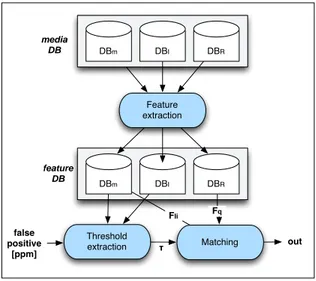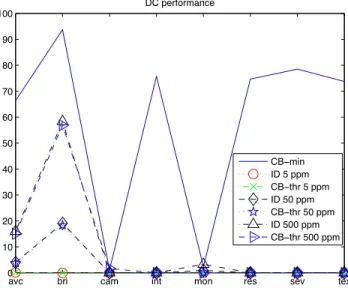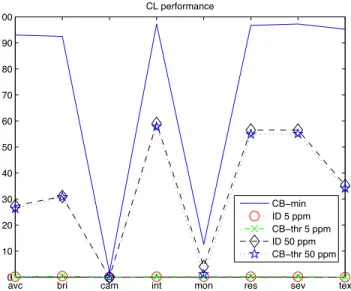IDENTIFICATION VERSUS CBCD: A COMPARISON OF DIFFERENT EVALUATION
TECHNIQUES
M. Corvaglia, F. Guerrini, R. Leonardi, E. Rossi
DEA-SCL, University of Brescia, Italy
ABSTRACT
Fingerprint techniques have a significant advantage in re-spect of watermarking: a fingerprint can be extracted in each moment of the lifetime of a multimedia content. This aspect is fundamental to solve the problem of copy detection mainly because many copies can be available in huge amount of data in circulation and because each copy can be attacked in sev-eral ways (compression, re-encoding, text-overlay, etc.). In this paper the problem of copy detection is studied and tested from two different point of views: content based and identifi-cation approaches. The results show that the proposed system is quite robust to some copy modifications and most of all show that the overall results depend on the evaluation method used for testing.
1. INTRODUCTION
The amount of digital video content present in TV Channels, Internet and Video Web Servers is ever growing thanks to the progress of multimedia and networking technologies. Due to the incredible amount of data, the monitoring of media usage becomes of great importance for various reasons.
First of all, the media should be controlled for copyright management: both the owners of web servers and the pro-prietors of copyright protected media should check if a given content has the right to be distributed, how and where it is used. Another application is media usage monitoring, which aims at supervising the correct placement of visual items such as advertising. Finally, the same material can be present on various sites and there should be the chance to create links by analyzing video and visual objects instead of text annotation. These aspects can be seen in a general way as the detec-tion and the correct identificadetec-tion of duplicated visual media. The solution is a tricky task because of the large amount of multimedia content to deal with and because each visual item can suffer different editing operations and modifications in terms of color, gamma, text or logo insertion geo,metric trans-formations, etc. that make a copy often less similar to the original video than another video.
A well known approach for the detection of duplicated visual media is given by watermarking, which consists in the insertion into the video stream of an imperceptible digital sign
called watermark that can be later retrieved to uniquely iden-tify the content origin and/or to establish its ownership. Wa-termarking presents two main disadvantages. First, the video should be pre-processed before its distribution to insert the watermark which is not a realistic condition for huge amount of video data in circulation. Second, watermarking is not ro-bust enough to properly identify multimedia material that has been severely attacked (re-encoding, text-overlay, etc.)
Recently alternative approaches have been considered in order to overcome the evident limitations of watermarking in the considered field of interest. Fingerprinting approach is a passive technique and does not require any pre-processing be-cause the content itself and intrinsic measurements are used to identify the uniqueness of a video. Given a certain video, its fingerprint consist of a significant set of features opportunely extracted and combined with the purpose to be robust across the common editing operations and sufficiently different for every original content to identify it uniquely and reliably.
In this paper a fingerprinting technique based on visual features is proposed. Its effectiveness has been evaluated un-der two different perspectives. In the first one the fingerprint is used to detect the transformed version of an original video; in literature this problem is called Content Based Copy De-tection (CBCD). In the second case the fingerprint is used to verify its uniqueness and robustness in the identification pro-cess.
Several techniques have been proposed to solve the prob-lem of CBCD. They can be divided into two main groups, namely those relying on global descriptors and those based on local descriptors. The first kind of descriptor is extracted from the whole frame. An example of global descriptor is the ordinal measure [1] , which consists in dividing the im-age into small blocks and then sorting each block depending on its average gray level: the signature is the rank of each block. Other global descriptors are the YUV color histogram of each frame or the block-based motion direction [2]. The main disadvantage of global descriptors is the lack of robust-ness against some attacks, for example caption insertion and geometric transformations, such as zoom, crop and letter-box. To deal with this problem, the approaches based on local de-scriptors compute features only on selected points of a frame, also called points of interest, which can be detected by Harris interest point detector [3] or by the frame SIFT descriptor [4].
In [5], some points of interest are tracked along the video se-quence to reduce the amount of information and to take into account both spatial, temporal and dynamic behaviors of the local descriptor. The main drawback of local features based methods is their high computational cost.
In the case of identification, the first techniques were in-troduced for image identification [6] [7] etc. and were mainly based on different transform (wavelet, DCT, etc.) depending on application. Then many extensions for video and audio have been proposed [8].
The brief overview of the existing techniques shows that the approaches differ quite a lot according to the fact they try to solve the CBCD problem rather than the identification one. In this paper, the same approach is evaluated in both environ-ments in order to study how the performance of a technique can vary depending on the selected approach.
This paper is organized al follows. Section 2 presents dif-ferent kind of evaluation methods; Section 3 describes the proposed method; in Section 4 results are presented and dis-cussed. Finally, in Section 5 conclusions are drawn.
2. EVALUATION TECHNIQUES
Depending on the perspective, i.e., identification or CBCD, the performance evaluation technique is different.
2.1. Content based approach
In the case of CBCD, the approach is usually the exhaustive one. Given a database DBm of N multimedia items (e.g.,
images, videos or audio clips) Ii with i ∈ [1, N ], given a set
of features FIi that characterizes each item Ii, given a query
item Q extracted from a modified item of the database, given the feature FQextracted from the query, chosen an
appropri-ate distance measure D between the features, the exhaustive approach consists in computing all distances Di(i ∈ [1, N ]),
between FQ and FIi and to select the most similar item Ij
whose feature FIjhas the minimum distance with FQ : Dj =
min(FIi, FQ) with i ∈ [1, N ].
Two common parameters are usually considered, i.e., pre-cision, which is an indicator of the retrieved relevant items in the retrieved items, and recall, which indicates the retrieved relevant items in the overall number of relevant items in the database. In some cases these parameters are summarized in a single parameter F which is given by the weighted harmonic mean of the previous two.
Other parameters are the rate of false alarms and the prob-ability of miss. TRECVID [9] evaluation introduces a weighted sum of these parameters at different operating points.
2.2. Identification approach
In the case of identification, the aim is to verify if a certain query item Q, described by its features FQ, has been extracted
from a multimedia item Ii, described by its features FIiwith
i ∈ [1, N ], which is considered to be the right one available in the database DBm. This verification is performed by
comput-ing the distance DQibetween FQ and FIi and then
compar-ing it with a selected threshold τ . If the condition DQi≤ τ is
true, then Q is considered to be extracted from item V . The key point of this approach is the setting of the thresh-old. In this sense, MPEG community for the evaluation of MPEG-7 Video Signature Tool proposed to proceed in two steps [10]: in the fist step the threshold is defined while in the second one the identification comparison is performed.
More in details, at the fist stage, called Independence test, given a large database of videos DBIconsidered independent
among them and chosen a certain distance measure between the relative features, the threshold τ is determined by the dis-tance value which corresponds to the maximum false positive rate. MPEG proposes to set the false positive rate equal to 5 part per millions (ppm). At the subsequent stage, called Ro-bustnesstest, a set of query items Q are available at different level and kind of modifications (database DBR). Each query
Q described by FQis compared with the original item Ii
de-scribed by FIi. Thus they are considered related only if the
distance is below the threshold τ computed by the Indepen-dence test.
3. SYSTEM OVERVIEW
The proposed system is based on the use of multiple visual features, considering their development in time along both queries Q and original items Ii. The basic idea consists in
comparing the sequence of each feature extracted from the query with the same feature in the original item, through the use of a sliding window.
Feature extraction
Threshold
extraction Matching out DBm DBI DBR false positive [ppm] Fq τ feature DB DBm DBI DBR media DB FIi
Fig. 1. Framework of the proposed system
FIi and FQ respectively of each original item and query is
extracted and then stored in three separate databases. The de-velopment in time of FQis then compared with FIiaccording
to the evaluation technique (content based or identification) and considering a sliding window of the same duration of the query. The distance in each point of the sliding window is obtained averaging the local distances obtained applying the metric operator. When the sliding window has spanned the whole video item, it is possible to plot the distance between the query and the window of the original video item, with respect to the temporal position of the window in the video item. The global minimum of this function is considered the point where the query is positioned into the video.
The visual low-level features considered in this work are: MPEG-7 Dominant Color (DC): compact representation of the representative colors in a still image or video frame [11] . More specifically, it consists of the representative colors and their percentages in the image, plus spatial coherency and color variance for each dominant color. The distance measure considered to evaluate the distance between two video frames, described by their DCs, is the Earth Mover’s Distance [12].
MPEG-7 Color Layout (CL): compact and resolution-invariant representation that indicates the distribution of col-ors in a still image or video frame. This descriptor is obtained by applying the DCT transform on a 2-D array of local rep-resentative colours in Y Cb Cr color space [11]. The dis-tance measure considered to evaluate the disdis-tance between two video frames, described by their CLs, is the MPEG-7 standard distance.
Luminance Layout (LL): representation of the distribu-tion of luminance in an a still image or video frame. This de-scriptor, which a simplification of the Color Layout, has been introduced mainly to deal with monochrome videos. The dis-tance measure considered to evaluate the disdis-tance between two video frames, described by their LLs, is the L1norm.
4. EXPERIMENTAL RESULTS
Experiments have been performed using a part of the data set available for MPEG-7 Video Signature Tool standardization. The main database DBmis composed by 1900 video items of
3 minutes. The Independent database DBI is composed by a
11300 clips of 2 seconds, which have been extracted from the videos available in DBm and which have been divided
by source in oder to guarantee the independency in threshold setting. The Robustness database DBRcontains 545 queries
of 2 seconds subjected to 9 transformations (VCR recording, brightness change, camera recapturing, interlaced/progressive conversion, grayscale conversion, frame-rate reduction, reso-lution reduction, severe compression and text/logo overlay) with Light strength of attack; in total the number of consid-ered queries is 4905. For each video of the three databases, features DC, CL and LL are extracted and stored in identical databases (Figure 1).
The system proposed in Section 3 has been tested in three conditions:
– Content Based (CB-min): as described in Section 2.1, each query of DBRis compared with all the item of DBm
(exhaustive approach) and the query candidate is obtained considering the minimum distance;
– Identification (ID): as described in Section 2.2, using DBIthree thresholds have been extracted by setting the false
positive rate to 5 ppm, 50 ppm and 500 ppm; then each query of DBRis compared with the relative item of DBmin order
to decide if the query is related or not;
– Content Based with threshold (CB-thr): exhaustive ap-proach (CB-min) is refined considering the minimum distance only if it is below a threshold defined in the identification ap-proach (ID).
The performance results of the different features in terms of Detection Rate (%) for each modification are shown in Fig-ure 2, 3 and 4. The classical parameters recall and precision have not been used because they are not applicable in the case if Identification test.
avc bri cam int mon res sev tex
0 10 20 30 40 50 60 70 80 90 100 DC performance CB−min ID 5 ppm CB−thr 5 ppm ID 50 ppm CB−thr 50 ppm ID 500 ppm CB−thr 500 ppm
Fig. 2. Performance of DC feature varying the evaluation method
If we consider the results for CB-min evaluation method, we can observe that the features act similarly. The Detection Rate is higher that 70% for all modification with exception for camera recapturing (cam) and grayscale conversion (mono). We can also note that LL provides the best performance for grayscale conversion (mono) and that CL reaches the 90% for most of the modifications.
If we consider the results for the other two approaches (CB-thr and ID), we can clearly see that the performance are seriously compromised. As mentioned above the choice of the threshold is a crucial aspect that should be carefully dealt with. For example, the threshold obtained by the Indepen-dence test with false positive rate set to 5ppm provides
per-avc bri cam int mon res sev tex 0 10 20 30 40 50 60 70 80 90 100 CL performance CB−min ID 5 ppm CB−thr 5 ppm ID 50 ppm CB−thr 50 ppm
Fig. 3. Performance of CL feature varying the evaluation method
avc bri cam int mon res sev tex
0 10 20 30 40 50 60 70 80 90 100 LL performance CB−min ID 5 ppm CB−thr 5 ppm ID 50 ppm CB−thr 50 ppm ID 500 ppm CB−thr 500 ppm
Fig. 4. Performance of LL feature varying the evaluation method
formance closed to null, while with false positive rate set to 50/500ppm the performance significantly increases. In this sense the Independence test forces the threshold to a value that is not the optimum for every technology.
5. CONCLUSIONS
In this paper a comparison of two evaluation techniques for copy detection is reported: one method is based on the classic exhaustive approach while the other one on the identification approach.
The tests have been performed using the video dataset provided by MPEG for MPEG-7 Video Signature Tool
stan-dardization. The results show that the evaluation method can seriously compromise the performance evaluation (the exhaus-tive approach provides significantly better results than the iden-tification one). Moreover the choice of the threshold is crucial and the proposed system needs to be improved for the critical query modifications.
6. REFERENCES
[1] D. Bhat and S. Nayar, “Ordinal measures for image cor-respondence,” IEEE Trans. on Pattern Analysis and Ma-chine Intelligence, vol. 20, no. 4, pp. 415–423, 1998. [2] A. Hampapur, K. Hyun, and R. Bolle, “Comparison
of sequence matching techniques for video copy detec-tion,” in SPIE Conf. on Storage and Retrieval for Media Databases, San Jose, CA, USA, Jan. 2002, pp. 194–201. [3] A. Joly, O. Buisson, and C. Frelicot, “Content-based copy retrieval using distortion-based probabilistic simi-larity search,” IEEE Trans. on Multimedia, vol. 9, no. 2, pp. 293–306, Feb. 2007.
[4] D. Lowe, “Distinctive image features from scale-invariant keypoints,” Int. Journal of Computer Vision, vol. 60, pp. 91–110, 2004.
[5] J. Law-To, O. Buisson, V. Gouet-Brunet, and N. Bouje-maa, “Robust voting algorithm based on labels of be-havior for video copy detection,” in ACM 14th Annual Int. Conf. on Multimedia, 2006, pp. 835–844.
[6] R. Venkatesan, S. M. Koon, M. H. Jakubowski, and P. Moulin, “Robust image hashing,” in ICIP’00 - IEEE Int. Conf. on Image Processing, Vancouver, Sept. 2000. [7] P. Brasnett and M. Bober, “Fast and robust image
iden-tification,” in ICPR08, 2008, pp. 1–5.
[8] B. Coskun, B., and N. D. Memon, “Spatio-temporal transform based video hashing,” IEEE Tran. on Multi-media, vol. 8, no. 6, pp. 1190–1208, 2006.
[9] A. Smeaton, P. Over, and W. Kraaij, “Evaluation cam-paigns and TRECVid,” in ACM 8th Int. Workshop on Multimedia Information Retrieval, 2006, pp. 321–330. [10] MPEG Doc. No. W10154, Updated Call for Proposals
on Video Signature Tools, Lausanne, Switzerland, Oct. 2008.
[11] B.S. Manjunath, P. Salembier, and T. Sikora, Introduc-tion to MPEG-7 - Multimedia Content DescripIntroduc-tion In-terface, John Wiley And Sons, LTD, 2002.
[12] Y. Rubner, C. Tomasi, and L. J. Guibas, “A metric for distributions with applications to image databases,” in IEEE Int. Conf. on Computer Vision, Bombay, India, 1998.


